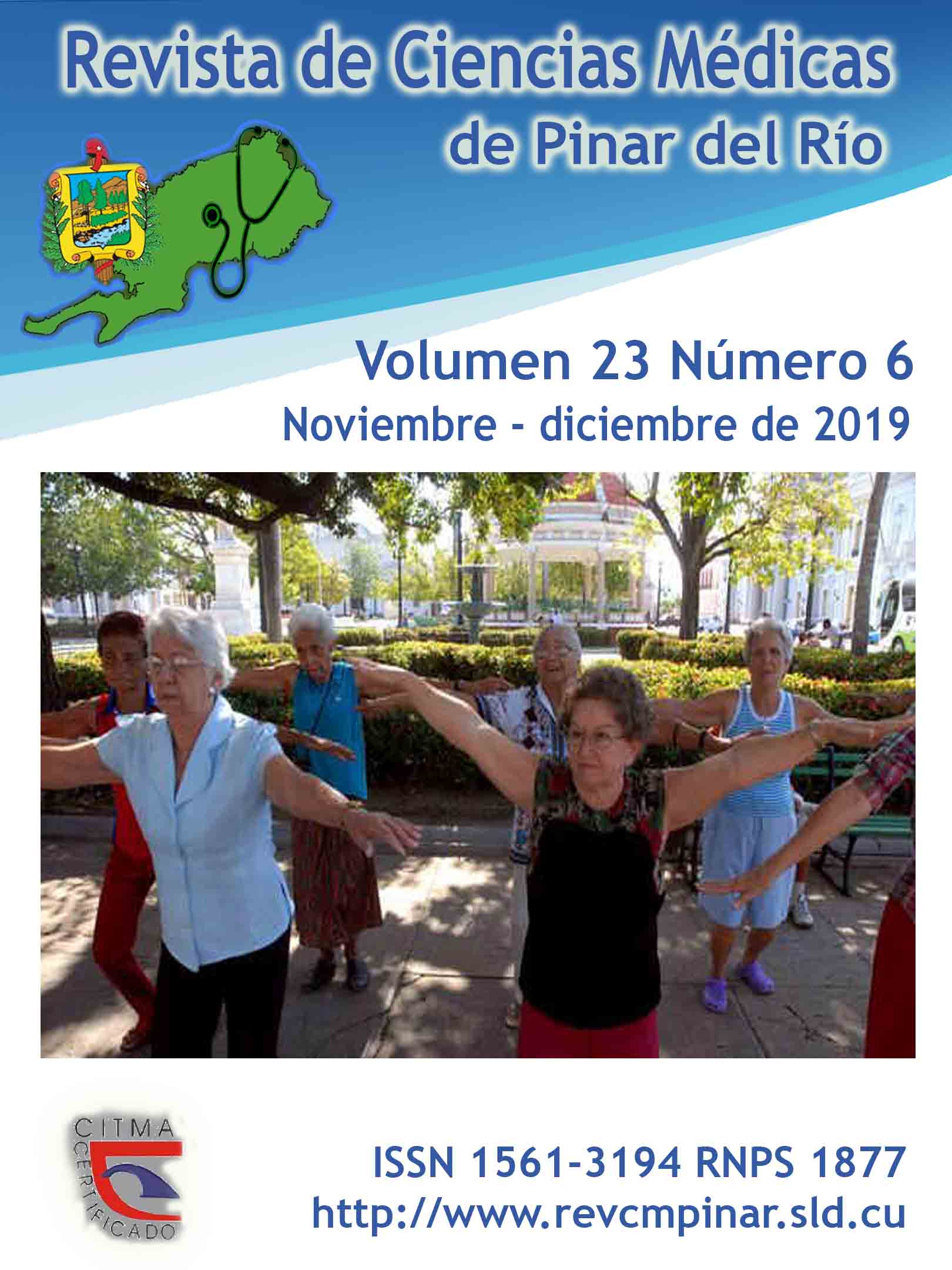Bach flower remedies and Psychological Counseling for Women Victims of Psychological Violence
Keywords:
VIOLENCE, WOMEN, DOMESTIC VIOLENCE, RISK FACTORS, EPIDEMIOLOGY.Abstract
Introduction: psychological violence increasingly affects the physical, psycho-emotional and social health of those who experience it. It is vitally important to choose a comprehensive therapeutic resource that contributes to diminish the symptoms identified in women victims of psychological violence.
Objective: to assess the results of Edward Bach's flower remedies and psychological counseling in women victims of psychological violence.
Methods: a mixed approach, descriptive, multiple-case, cross-sectional research was carried out at No. 22 clinic belonging to Idalberto Revuelta polyclinic in Sagua la Grande, Villa Clara province.
Results: emotional types were identified in women such as: fear, anxiety, guilt feelings, depression, sadness, low self-esteem, and presence of psychological traumas in previous stages of their ontogenetic development, loneliness, hopelessness, among others. Among the flower essences applied were: Star of Bethlehem, Mimulus, Gorse, Gentian, Impatiens and Centaury.
Conclusions: the result of the treatment with flower remedies and psychological orientation, were applied to them individually, assessing the effectiveness of Edward Bach's flower remedies (BFRs) which was determined in order to diminish the symptoms identified in women victims of psychological violence, as part of their comprehensive treatment.
Downloads
References
1. González Leal EG, Pardo Gómez ME, Izquierdo Lao JM. La violencia como problema de salud pública en Venezuela: algunas reflexiones desde la perspectiva del profesional de seguridad ciudadana. MEDISAN [Internet]. 2017 [citado 30/01/2019]; 21(5): [aprox. 0p.]. Disponible en: http://medisan.sld.cu/index.php/san/article/view/1545
2. Yugueros García AJ. Prevención y atención integral a las víctimas de Violencia de Género en la Comunidad Valenciana. Carolina del Norte- EEUU. Derecho y Ciencias Sociales; 2018.
3. Flores Villavicencio ME, González Pérez GJ, Vega López MG. Problemas de salud en los adolescentes: Una perspectiva socio epidemiológica. Universidad de Guadalajara: Editorial UNIVERSITARIA; 2015.
4. Alzate NA, Urbina P. Informe eventos violencia de género actualización 2017. Dirección territorial. Salud de Caldas; 2017. Disponible en: http://www.observatorio.saluddecaldas.gov.co/desca/saludm/Informe%20evento%20875%20Violencias%20de%20g%C3%A9nero%20Semestre%20I%202017.pdf
5. Noa L, Creagh Y, Durán Y. La violencia psicológica en las relaciones de pareja. Una problemática actual. [Internet]. 2014. [citado 23/11/2017]; 88(6): [aprox. 9p.] Disponible en: http://revinfcientifica.sld.cu/index.php/ric/article/view/1100
6. Rodríguez Calvo MD, Gómez Mendoza C, Guevara de León T, Arribas Llopis A, Duarte Duran Y, Ruiz Álvarez P. Violencia intrafamiliar en el adulto mayor. Archivo Médico Camagüey [Internet]. 2018 [citado 30/01/2019]; 22(2): [aprox. 9 p.]. Disponible en: http://www.revistaamc.sld.cu/index.php/amc/article/view/5548
7. Hidalgo García L, Valdés López DC. Violencia contra la mujer adulta en las relaciones de pareja. MEDISAN [Internet]. 2014 Feb [citado 28/02/2019]; 18(2): [aprox. 6p.]. Disponible en: http://scielo.sld.cu/scielo.php?script=sci_arttext&pid=S1029-30192014000200006&lng=es.
8. Calvo González G, Camacho Bejarano R. Gender violence: trends, impact and keys for approach. Enferm. glob. [Internet]. 2014 Ene [citado 25/02/2019]; 13(33): [aprox. 15p.]. Disponible en: http://scielo.isciii.es/scielo.php?script=sci_arttext&pid=S1695-61412014000100022&lng=es.
9. López-Angulo L, Fundora-Quintero Y, Valladares-González A, Ramos-Rangel Y, Blanco-Fleites Y. Prevalencia de la violencia física y psicológica en relaciones de pareja heterosexuales. Revista Finlay [Internet]. 2015 [citado 25/02/2019]; 5(3): [aprox. 8p.]. Disponible en: http://www.revfinlay.sld.cu/index.php/finlay/article/view/371
10. Rodríguez Lado DC, Sori Díaz Y, Barceló Tellería JA. Necesidad de un protocolo integrado de Medicina Natural y Tradicional dirigido al paciente oncológico. Medicentro Electrónica [Internet]. 2019 Mar [citado 25/02/2019]; 23(1): [aprox. 3p.]. Disponible en: http://scielo.sld.cu/scielo.php?script=sci_arttext&pid=S1029-30432019000100014&lng=es.
11. Hernández-Ramírez G, Barbán-Pernía J, Barbán-Hernández G, Paumier-Rodríguez I, Montero-Paumier I. Terapia floral y adolescencia. MULTIMED [Internet]. 2017 [citado 25/02/2019]; 19(6): [aprox. 10p.]. Disponible en: http://www.revmultimed.sld.cu/index.php/mtm/article/view/435
12. Casañas Morales B. La terapia floral personalizada. Barcelona: SEDIBAC; 2017. Disponible en: https://sedibac.org/wp-content/uploads/2013/03/tema.-Tratamiento-para-los-miedos.pdf
13. Orozco R. Flores de Bach: Patrón transpersonal y aplicaciones locales Territorios. España: El Grano de Mostaza Ediciones; 2017. Disponible en: https://elgranodemostaza.com/wp-content/uploads/2017/04/flores-bach-patr%C3%B3n-transpersonal-ebook.pdf
14. Díaz Castro Y, Rivero Brito AM, Tamargo Barbeito TO. Orientación psicológica y terapia floral combinada como alternativas de tratamientos en trastornos adaptativos en niños. Rev Cubana de Medicina Natural y Tradicional [Internet]. 2016 [citado 25/02/2019]; 1(2). Disponible en: http://www.revmnt.sld.cu/index.php/rmnt/article/view/37/42
Published
How to Cite
Issue
Section
License
Authors who have publications with this journal agree to the following terms: Authors will retain their copyrights and grant the journal the right of first publication of their work, which will be publication of their work, which will be simultaneously subject to the Creative Commons Attribution License (CC-BY-NC 4.0) that allows third parties to share the work as long as its author and first publication in this journal are indicated.
Authors may adopt other non-exclusive license agreements for distribution of the published version of the work (e.g.: deposit it in an institutional telematic archive or publish it in a volume). Likewise, and according to the recommendations of the Medical Sciences Editorial (ECIMED), authors must declare in each article their contribution according to the CRediT taxonomy (contributor roles). This taxonomy includes 14 roles, which can be used to represent the tasks typically performed by contributors in scientific academic production. It should be consulted in monograph) whenever initial publication in this journal is indicated. Authors are allowed and encouraged to disseminate their work through the Internet (e.g., in institutional telematic archives or on their web page) before and during the submission process, which may produce interesting exchanges and increase citations of the published work. (See The effect of open access). https://casrai.org/credit/



